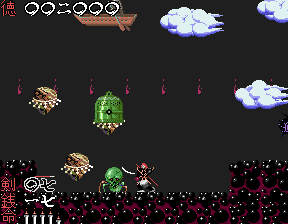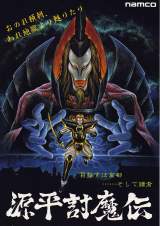
Genpei Toumaden © 1986 Namco.
Genpei Touma Den is a multi-genre birds-eye view action, 2D side-scroller beat 'em up, and 2D side-scroller platform arcade game that was released by Namco in 1986 only in Japan.
The character controlled by the player is that of a real Japanese samurai, Taira no Kagekiyo, who fell at the Battle of Dan-no-ura at the end of the Genpei War in 1185. Over eight hundred years later he is resurrected and has to make his way over the Imperial Regalia of Japan - fighting other characters who actually existed such as Minamoto no Yoshitsune and Saito Musashibo Benkei on his travels, as well as collecting the three sacred game items and defeating his arch-enemy Minamoto no Yoritomo.
This game has three types of stages: Small Mode (standard), Big Mode (with large characters, and usually boss fights), and Overhead Mode (like Small Mode, but as the name suggests, viewed from an overhead perspective). Most stages have torii (a gate) at the end of them, which are used to transport the player to a different stage. Most of the Small Mode and Overhead Mode stages have multiple torii at the end of them, which lead to different places on the map of the Imperial Regalia. Big Mode stages, however, only have one torii at the end of them. If Kagekiyo is unlucky enough to fall into a pit in any of the Small Mode stages, he will end up in a non-standard Overhead Mode stage known as the "Pit Stage" (from which there are only two ways to escape - and one of these two does not always work).
The game also features the Sanzu River, the place believed in Japanese Buddhism to separate "the current life" and "the afterlife", resembling the concept of the Underworld or Hell. Therefore, mythological characters such as Emma-O, God of the Underworld, and Sun Goddess Amaterasu, appear in this game (the former in the aforementioned "Pit Stage" and the latter in a non-standard Small Mode stage called the "Bonus Stage").

Namco System 86 hardware
Game ID : GT
Main CPU : (2x) M6809 (@ 1.536 Mhz), Hitachi HD63701 (@ 1.536 Mhz)
Sound Chips : Yamaha YM2151 (@ 3.57958 Mhz), Namco 8-channel WSG, Namco (@ 6 Mhz)
Screen orientation : Horizontal
Video resolution : 288 x 224 pixels
Screen refresh : 60.61 Hz
Palette colors : 512
Players : 2
Control : 8-way joystick
Buttons : 2
Genpei Toumaden was released in October 1986 in Japan.
The title of this game translates from Japanese as 'Genji and Heike Clans Defeat Demon Story'.
Alfa Records released a limited-edition soundtrack album for this game (Namco Game Music Vol.1 - 28XA-170) on July 25, 1987.
Kagekiyo will be travelling through ancient Japan consisted by three types of stages:
Small Mode stages: Kagekiyo will need to pass through obstacles without falling into the pit.
Big Mode stages: Kagekiyo will encounter strong enemies. As a result, he is able to use more moves during these stages.
Over Mode stages: There are only a few of these top view stages, but most of them are very important. In this mode Kagekiyo cannot jump over enemies, but he can jump over certain obstacles or reach some enemies.
Game interface:
Numbers: The numbers used in game's score display, along with sword and Zeni counters, are in Kanji numerals instead of Arabic ones, which were later reused in Mirai Ninja for the protagonist's life meter.
Sword power "Ken": This value shows Kagekiyo's attack power and sword durability. Kagekiyo starts with seven points, and can increase by collecting purple orbs or buyable swords, up to a value of 99. However, if he cuts anything too hard, his sword point may decrease, unless he has the Kusanagi Sword. If his sword power drops to zero, his attack power will decrease, and his sword will be shown as broken in Big Mode.
Money "Zeni": Kagekiyo will need to buy some items, or escape from the pit via blood pool, with Zeni. Collect this from enemies, up to 99.
Life candles "Inochi": Kagekiyo's life bar is shown as candles, each representing up to 10 life points depending on length. If Kagekiyo loses all life points, it is game over. Kagekiyo starts with 50 life points (can be changed between 40 to 70 in arcade version), can recover with blue orbs and tawara, and can extend life capacity with candle or brown orbs pickup, up to 100. When Kagekiyo enters a torii, he will recover to 40 life points if lower than the value. However, if Kagekiyo falls into the Pit, he will lose all life extends and start the stage with less than 20 life points. During a boss fight, the lifebar of the boss will be shown as purple candles.
Sacred items: Kagekiyo must collect all three items in order to defeat Yoritomo. Items collected will be shown on screen.
General Tips:
You cannot jump from a falling platform.
Do not waste your sword points. Only attack hard enemies when necessary or with a scroll.
Always collect some money in order to buy swords and health recovery, or even an escape from the Pit.
UNopened boxes and enemy generators can be used as jumping platforms.
In the bonus stage, aim for sword points first.
1. Genpei Toumaden (1986, Arcade)
2. Genpei Toumaden ni no Maki [Model NC92002] (1992, PC Engine)
Music composed by : Norio Nakagata
CONSOLES:
Nintendo Famicom (oct.21, 1988) "Genpei Toumaden - Computer Boardgame [Model NAM-GT-4900]"
NEC PC-Engine (mar.16, 1990) "Genpei Toumaden [Model NC90001]"
Sony PlayStation (nov.8, 1996) "Namco Museum Vol.4 [Model SLPS-00540]"
Sony PlayStation (1997) "Namco Museum Vol.4 [Model SCES-00701]"
Sony PlayStation (june.30, 1997) "Namco Museum Vol.4 [Model SLUS-00416]"
Sony PlayStation (aug.1997) "Namco Museum Vol.4 [Model SCES-00701]"
Nintendo Wii [Virtual Console Arcade] (mar.31, 2009)
COMPUTERS:
Sharp X68000 (apr.1988) by Dempa Shinbunsha
Game's ROM.